The Best Couples Yoga Poses
This article originally appeared on Yoga Journal
When you love your yoga practice, you want to share it--especially with the people you care about. And why not? Yoga has proven benefits for body and soul. Those benefits can be multiplied if you practice yoga poses as a couple.
A 2017 study found that people who exercised with others reported better mental, physical, and emotional well-being, as well as a 26 percent reduction in stress. (People who went solo worked out twice as long without significant benefits.) Other research shows that couples who engage in activities together experience greater relationship satisfaction. Establishing a regular routine such as yoga can also nurture closeness. Loyola University’s Sexual Wellness Clinic included yoga in their programs to help couples “build trust, relax and have fun.”
Having someone to practice with can help you be more accountable and consistent with your practice. And in an age when some people may still be wary about doing yoga in a large group, practicing yoga poses as a couple means you don't have to go it alone.
4 tips for practicing couples yoga poses
When you think of yoga poses for couples, you may conjure images of people doing complicated yoga acrobatics. You don't have to be adept at AcroYoga to have a fun, fulfilling partner practice. Practicing yoga poses for couples is a way to practice together and support one another physically and emotionally. If you decide to invite a partner to practice with you, be mindful of keeping it peaceful and pleasurable for both parties. Here are some practice tips:
Choose teaching or tandem
If one of you is more experienced, decide whether this is a teachable moment or if you're doing the practice in tandem. If you are spending time instructing, correcting, or adjusting your partner, you may be missing out on your own practice. That's okay as long as you both agree that this dynamic is mutually beneficial. But if you want your practice to be a bonding moment as a couple, this is the time to get out of teacher mode and share the experience.
Avoid push and pull
Unless you are a yoga instructor with an expertise in hands-on adjustments, be extremely careful with physically manipulating your partner during a practice. Trying to push or pull someone's body into a pose could cause more harm than good. Obviously if your yoga buddy is in a position that might lead to injury, offer some guidance or suggest you both try a different variation.
Keep ego out of it
A little friendly competition can be motivating for certain kinds of workouts. But yoga has a built-in non-compete clause: One of the goals of the practice is to let go of asmita, which can be translated as egoism. It’s one of the five kleshas or afflictions that yoga practice is designed to nullify. Twinges of competitiveness are pretty normal-even with someone you care about--but they may indicate that you have put your attention on comparing yourself to the other person. Instead, focus on practicing yoga poses with your partner, not competing against them.
Have fun
Your love of yoga may be fierce, but that doesn't mean it can't be fun-especially when you're sharing it with a loved one. When you're spending precious time practicing couples yoga poses, focus on your togetherness more than accomplishing some goal on the mat.
Best couples yoga poses
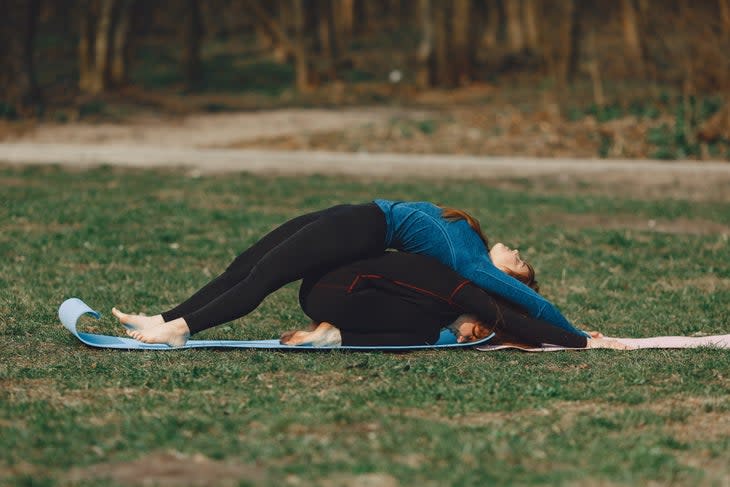
Balasana (Child's Pose) and Matsyasana (Fish Pose) for couples
Partner 1, begin in Tabletop. On an exhale, press your hips back into Extended Child's Pose, with your knees together or apart, and your arms reaching out over your head.
Partner 2, sit in Dandasana (Staff Pose), facing away from your partner with your hips at their feet. Inhale and allow yourself to arch your back and lean back onto Partner 1.
You can allow your shoulders to fall back and your arms to rest by your sides in a more traditional Fish Pose. Or, for more of a stretch, reach your arms overheard and allow them to align with your partner’s extended arms. Press your feet into the mat, lift your hips and arch back further, aligning your spine with your partner’s.
Hold or 3-5 breaths.
To release, Partner 1 inhale, lower your hips, engage your abs, and lift your torso to return to Dandasana. Partner 2, return to Tabletop. Switch positions.
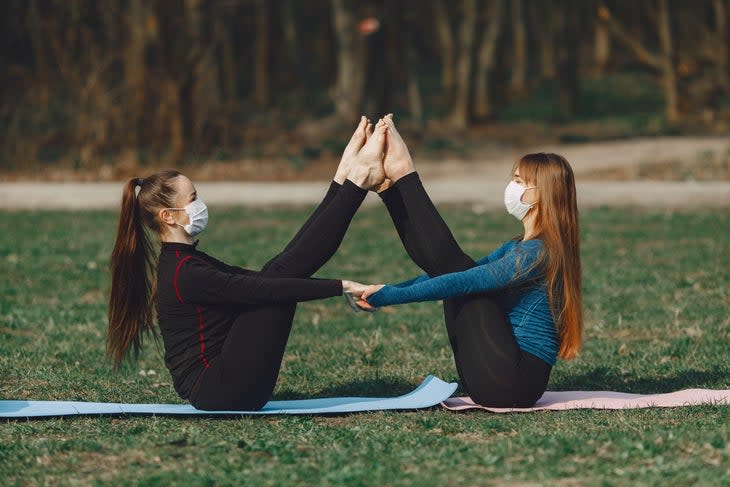
Paripurna Navasana (Boat Pose) for couples
Both partners, begin in a seated position, facing each other, with your knees drawn in toward your chest and the soles of your feet on the mat. You want to be approximately 3 feet apart.
Place your hands on the mat a little behind your hips. Lean back slightly, keeping your spines long and straight and making sure your backs don’t round. Find a balance point between the sacrum and sitting bones.
Exhale and lift your feet off the mat, bringing your shins parallel to the mat. Press the soles of your feet against your partner’s.
Draw your shoulders back and extend both arms toward your partner, parallel to the mat, keeping your heart open. Reach forward to clasp hands with your partner.
Pressing your soles together, slowly straighten your legs, bringing them up toward the ceiling. Your two bodies will form a W shape.
Try to keep your lower belly engaged and your back straight as you lean away from each other.
Breathe. Try to stay in the pose for 10 to 20 seconds, then return to seated position.
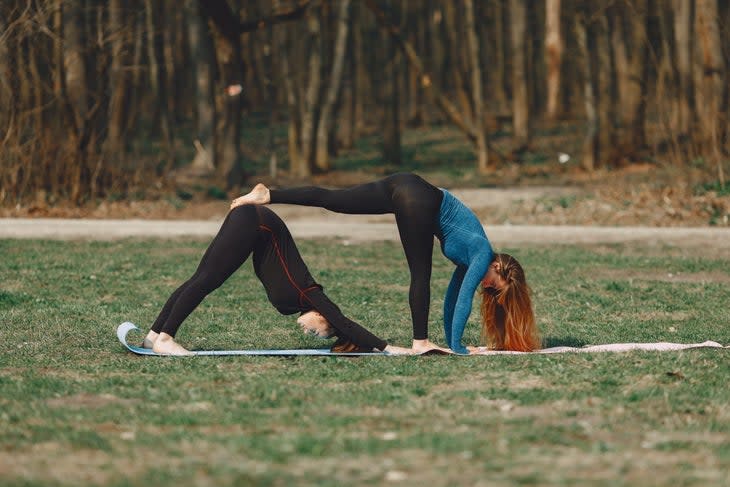
Adho Mukha Svanasana (Downward-Facing Dog Pose) and Virabhadrasana III (Warrior III Pose) variation for couples
Both partners begin Tadasana (Mountain Pose), one in front of the other.
Partner 1, fold forward and place your hands on the mat. Walk your hands away from your feet to come into Downward-Facing Dog Pose.
Partner 2, lift your left knee to balance on your right leg. Slowly extend your left leg straight back and you lean your torso forward. (Be careful not to kick your partner!) Allow the top of your foot to rest on your partner’s glute.
Partner 2 can create a straight line from your foot to the crown on your head in a traditional Warrior III. Your arms can be in Anjali mudra, straight out at your sides, reaching back toward your feet, or extending out in front of you. Alternately, you can bring your hands down to rest on the mat a few inches in front of your feet.
Stay for 30 seconds to 1 minute. Then, Partner 1 lowers to Tabletop or Child’s pose as Partner 2 lowers the raised leg and returns to Tadasana.
Repeat on the other leg for the same length of time. Then switch partner positions and repeat the poses.
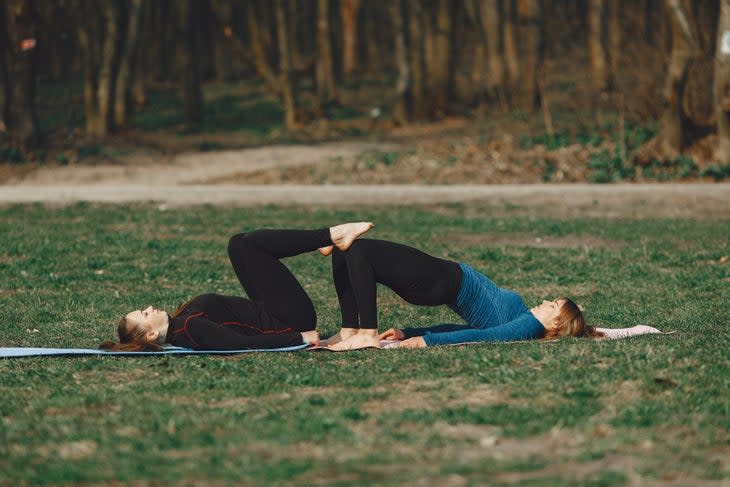
Setu Bandha Sarvangasana (Bridge Pose) with Wind Relieving Pose for couples
Partner 1, lie on your back and bring your legs straight up in Waterfall position. Align your ankles, knees, and hips.
Partner two, lie down so that our feet are near your partner’s hips. Position yourself so that your knees are bent, your legs and feet parallel and hip-distance apart.
Partner 1, lower both feet and place them gently on the top of Partner 2’s knees.
Partner 2, press down firmly through your feet and inhale as you raise your hips. Keep your knees from splaying out. (Your partner can help you here by keeping their feet parallel.) Clasp your hands under your back on the mat or place them, palm down on the mat.
Partner 1, as your partner lifts their hips, exhale and allow your knees to come toward your face. Keep your neck long. Feel a release in your lower back.
Stay for 30 seconds to 1 minute. On an exhale, Partner 2, lower your hips to the mat. Partner 1, bring your feet to the mat on the outside of your partner’s hips.
Both partners, allow your backs to rest in a neutral position for several breaths, then switch sides.
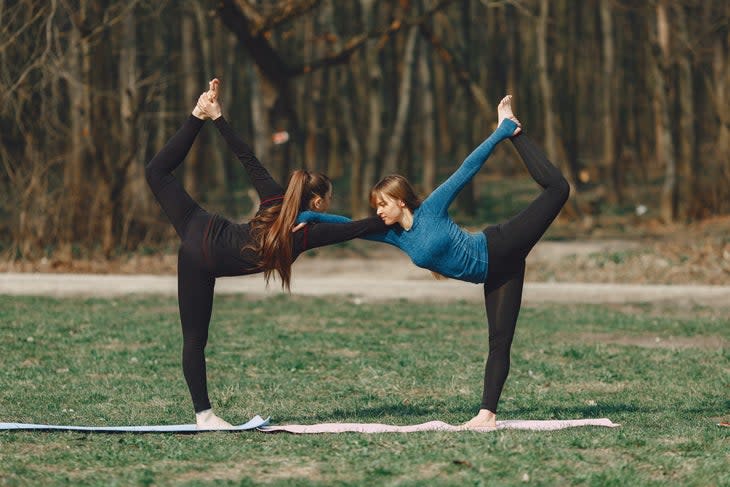
Natarajasana (Lord of the Dance Pose) for couples
Both partners, stand in Tadasana (Mountain Pose) facing one another. Depending on your height, you may be 3-4 feet apart.
Each partner, reach your right arm straight ahead and place it on your partner’s right shoulder.
Bend your left knee and bring your left heel toward your backside. Reach back with your left hand to clasp your ankle.
Using one another as support, press your right thigh back and up, and press the top of your foot away from you.
Lean your chests toward each other.
Hold for 5-10 breaths, then release back to Tadasana.
Repeat on the opposite side.
For exclusive access to all of our fitness, gear, adventure, and travel stories, plus discounts on trips, events, and gear, sign up for Outside+ today.

